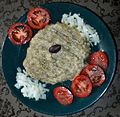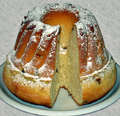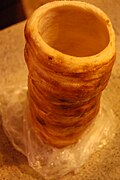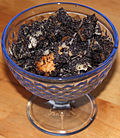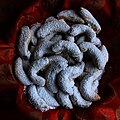Soups and stews
| Name | Image | Region | Description |
|---|---|---|---|
| Borleves | A fresh and strong wine soup. | ||
| Csirkepaprikás |  | A stew with a lot of sweet paprika, cream or sour cream called tejföl . | |
| Csontleves |  | A basic bone broth, usually served with spaghetti noodles, carrots, and turnips. It may also be served with stewed meat (usually pork), meat bones or parsley. | |
| Főzelék |  | A type of thick Hungarian vegetable stew or soup, similar to pottage. | |
| Gombaleves |  | A soup made from various wild mushrooms, often added with sour cream, but not necessarily the same as the cream of mushroom soup. | |
| Gombapaprikás | A mushroom paprikash, which is a traditional vegetarian dish of the Hungarians. | ||
| Gulyás Goulash |  | A stew of meat and vegetables, seasoned with paprika and other spices. | |
| Gulyásleves |  | A Hungarian soup, made of beef, vegetables, ground paprika and other spices. | |
| Gyümölcsleves |  | Southwestern Hungary | A chilled, sweet soup with redcurrants, blackberries, sour cherries, apple, pear, quince or other seasonal fruit mix. It is fast cooked with cream or whole milk, some spices often accompanied with fruits, like cloves and cinnamon and sugar. |
| Halászlé Fisherman's Soup |  | A hot, spicy, and paprika-based river fish soup, originating as a dish of Hungarian cuisine, that is prepared with generous amounts of hot paprika and carp or mixed river fish. | |
| Húsleves Chicken soup |  | A clear chicken or veal meat soup with soup vegetables and thin soup pasta called csipetke . | |
| Jókai bableves Jókai bean soup |  | A rich bean soup, with many vegetables, smoked pork hock pieces and noodles. It is often made to be spicy or some sort of hot chili offered with it. | |
| Köménymagleves | A fresh and hot caraway seed soup. | ||
| Krumplileves | 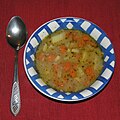 | Made from potatoes in a broth, frequently with slices of sausage, carrots, turnips or sour cream. | |
| Lecsó |  | Southeastern Hungary | A mixed vegetable stew, made of primarily tomato and paprika, also found throughout the Balkans and Central Europe. It is somewhat similar to ratatouille, but without squash and zucchini. A variety exists called tojásos lecsó (lecsó with eggs), which has scrambled eggs mixed in. |
| Marhapörkölt | A stew, which is very similar to chicken paprikash, except using beef. | ||
| Meggyleves Sour cherry soup |  | A slightly sweet soup made with sour cream, sugar and whole fresh sour cherries, and served as chilled. | |
| Pacalleves |  | A tripe soup eaten primarily by Hungarians living in Transylvania, usually seasoned with vinegar, sour cream, and garlic. May be eaten with bread and hot paprika on the side. Known as ciorbă de burtă for Romanians. | |
| Palócleves |  | Northeastern Hungary | A soup similar to gulyásleves, but containing green beans and sour cream, and frequently flavoured with dill. It is invented by János Gundel, who is the father of the famed chef Károly Gundel, and named for Kálmán Mikszáth and his writings about the Palóc people of northern Hungary and southern Slovakia. |
| Paprikás krumpli |  | A paprika-based stew with spicy sausage and potatoes. | |
| Pörkölt |  | A meat stew in a thick paprika-spiced sauce, similar to ragout; generally translated into English as goulash (not to be confused with goulash soup). | |
| Sólet |  | A Jewish-Hungarian stew made with kidney beans, barley, onions, paprika, and perhaps meat and eggs as well. It is similar to cholent. | |
| Sóskaleves |  | Made from sorrel leaves in a broth, often with boiled eggs as well. Similar to green borscht, but thicker. | |
| Székelygulyás (Székelykáposzta) |  | Transylvania | A hardy pork and sauerkraut stew, often flavored with paprika, onion, and sour cream. Despite its name, it does not originally come from Transylvania (Erdély), and is instead named after the Hungarian writer József Székely (a friend and contemporary of Sándor Petőfi), who apparently asked a kocsmáros (tavernman) to mix together leftover savanyúkáposzta-főzelék (sauerkraut pottage) and sertéspörkölt (pork stew) to create it. |
| Tojásleves |  | Same as köménymagleves, except with scrambled eggs added. Similar to the Slovenian national dish, prežganka. | |
| Vadgombaleves | A wild mushroom soup that originated in southern Hungary. | ||
| Zöldségleves |  | A soup with vegetables, such as peas, carrots, turnips, and parsley. | |






























